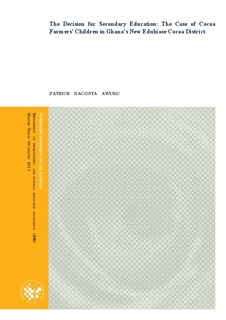The Decision for Secondary Education: The Case of Cocoa farmers' children in Ghan's new Edubiase Cocoa district.a Farmers' Children in Ghana's New Edubiase Cocoa District
Master thesis
Permanent lenke
http://hdl.handle.net/11250/187205Utgivelsesdato
2011-10-06Metadata
Vis full innførselSamlinger
- Master's theses (HH) [1072]
Sammendrag
Secondary (senior high) school is noted as an indispensable link between the basic and
tertiary levels of education in Ghana. Financing a child’s secondary education in Ghana however, is very challenging for the average Ghanaian, including the cocoa farmer. The tendency to use children extensively on the cocoa farm to the detriment of their secondary schooling appears to be very high. This study investigates the factors that influence
the cocoa farmer in deciding for the child between secondary schooling and work on the cocoa farm. The study area is the New Edubiase cocoa district in Ghana.
Survey results indicate that majority of the households in the study area use their secondaryschool-going children on the farm, to various extents. Secondary school children not involved in farming generally stay with other relatives outside the study area for their education. All the children who qualified for secondary school but are currently involved in only working on the farms are from relatively poor households. A vicious cycle seems evident, in which the relatively poor households produce less educated children, who become relatively
poor young adults and, in turn, become heads of relatively poor households.
The multinomial logit model was used to capture the choice probabilities across work and/or school options. Results generally show that important factors explaining the child secondary school/work outcome include parent’s education, gender of parents, gender and age of children, household wealth status, parent’s level of confidence in external financial assistance
and community characteristics.
Pragmatic efforts aimed at breaking the apparent cycle observed, are recommended.
